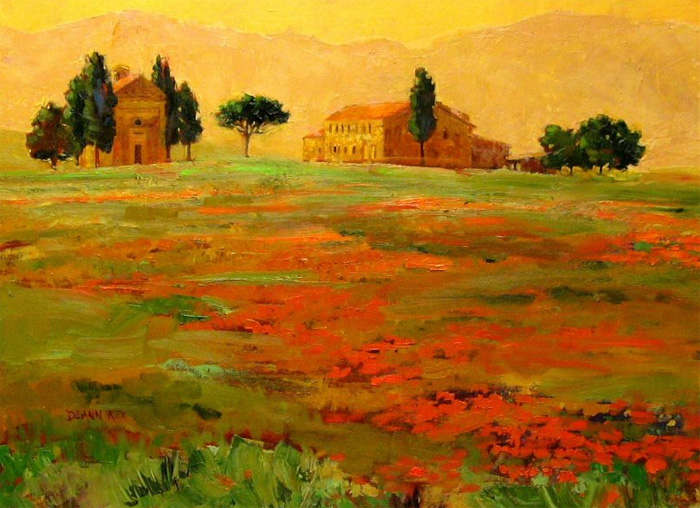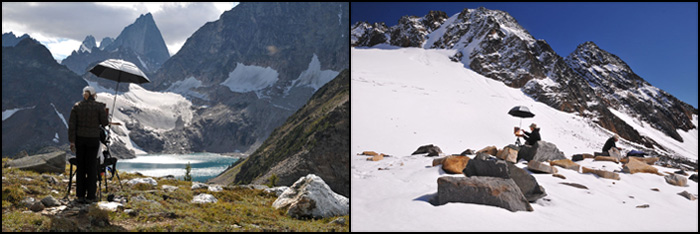(RG note) Thanks, Sam. How Successful Artists Study was mentioned in my letter An artist’s world on July 30, 2010. I found Sam Adoquei’s book to be a stimulating, energizing read and loaded with truly excellent advice, especially for young artists just out of art school. There is 1 comment for Endorsement of book by Sam Adoquei
Archived Comments
Enjoy the past comments below for Over the fireplace…
The obvious solution would be to hang a heavily-varnished giclee over the fireplace. That way if damage did occur, you would not have lost a one-of-a-kind painting. Perhaps the artist could furnish a giclee with the original (at a little above cost) if the image was to be hung in an “iffy” area like over the fireplace, in the kitchen, bathroom, or in a sunny location. The original could hang in a safer location. As a former sign designer, I’ve seen just how quickly the sun can bleach pigments, especially the reds.
Over a fireplace is not good. Neither over a blown air vent or a radiator. All things considered, however, I’ve found that the the most deteriorated of my older work has resulted from sunlight and poor materials, the latter being the most villainous circumstance. For years I was not particular about the materials, giving only casual attention to the archival quality of my supports. (Merely “acid free” doesn’t cut it.) Eventually this deficiency catches up with a work no matter where it’s hung. Hang the work where it is exposed to overmuch light and erratic or extreme temperatures and humidity, and disaster is in the offing. I find that I can do more about the archival nature than I can do about the ultimate wall placement of my wandering works.
As is more common these days, I have a mechanic who is culturally very savvy. He repairs cars in his garage by day, and is often a denizen of concert halls and galleries by night. While he has hung only a welded steel relief in the bays where daily cars are serviced, his office is totally unexpected and spectacular. One day I noticed an installation of dials along one wall. He had put climate controls in the small office of his garage. No fool of any kind, this man!
Over the fireplace is a bad choice, as are drafty places, direct sunlight and sudden changes in temperature and humidity. If only people took care of their paintings as they do of their plants! But as though I admire Mr. Genn as a painter and a teacher, my advice to him (and everybody else) is to leave conservation and restoration of easel painting to professionals, thats why they study for long, grueling years and would never, ever clean a painting with anything but the smallest q-tips and the appropiate solvents.
There are variables in “over the fireplace.” In south Texas we may have a fire four to six days in a season. In Alaska, our fireplace was continually fed for five months without ever cooling. Anyone living in a northern climate knows how the interior climate can ravage our skin every winter. One can only imagine what it is doing to a painting. We’ve all seen accent lights spot heating a painting on a dark wall. That can’t do a canvas much good either. Other than advising your client of those dangers its basically their painting after they buy it. I’ve never heard a gallery recommend to a buyer where to hang a painting; they probably should. Speaking of, a primer on cleaning a painting would be appreciated.
Modern, gas-fired fireplaces are much more efficient and radiate heat throughout a room and do not belch heat and soot upward as in the older, wood-fired type, which are now, in many jurisdictions, illegal. In many cases air tight and behind thermal glass, they should not be a problem to valuable paintings hung above them. In my experience over many years of service with approved installations, there is no issue.
England thought she was France and did not begin to install central heating until after the Second World War. The toll on art from coal hearths has been enormous. Newcastle
Hang Giclee prints over the fire place or in the sun room. When I sell a John Farnsworth reproduction I promise to replace it if anything damages it, for only replacement costs.
“MR. CLEAN”??? Robert, are you serious? I have a dirty old oil painting and I am afraid to clean it as it might damage it forever! Somewhere I read that one should use pieces of soft white bread to remove the dirt.
I think ” Over the Fireplace ” is a great place for a large painting but only for a maximum of 12 months. The painting should the be moved to another wall and a new painting should be purchased for ” Over the Fireplace.”
Yes, in the throwaway world, what does it matter if a giclee loses its colour after a few years over the fireplace or in the sun. It will probably be out of style anyway and need to be replaced by something else more current. It is only in old cabins, castles and heritage places where art needs to reflect the nature of the place.
Fire places are completely stupid in the first place. Seal it with an airtight enclosure. Get more heat with less wood, and hang anything you like above it.
Interesting opinions on art, where to hang it, and strangely enough fireplaces! We have a wood furnace in the front of the house and blown hotair heat in the rest of the house. Try as you might you will end up with a dry house. SKin suffers, art suffers, leatherhard clay….dries fast! I think if you are going to be buying artwork you ought to be taking where you plan on putting it into account before you ever write that check.
What should be avoided in hanging art is extreme changes in temperature. Also, never hang a recently painted oil near a lamp or other light source that produces heat. I had an instructor once who painted a portrait commission; it was hung near a lamp and the painting surface was ruined.
@Marie, thing is many people who buy art, aren’t the most knowledgeable about where to hang it or how to care for it. Some art but they tend to be more knowledgeable about art to start with. I just let it go, make the art and send it on it’s way. Once I have completed it and sold it, I have no more attachment to it. If someone comes back and says “I was using *** and it broke!! can you fix it?” I just show them new pieces (if it is ceramics, different mediums would change my response) I say make the work, send it to its new home and believe it has a great life there!
I was just about to donate or lend a piece of oil pastel to some friends for over their fireplace – had a sudden vision of dripping material and soot, so no go!
Fire is one of the central elements in all cultures (earth, air, fire, water). To place something of value over the fire is to honor it. Fire and its honoring is not going to go away, no matter how laundered and purified. What is interesting is that significant works of art for our homes are seldom placed over “water.”
I’ve had a piece over the fireplace for years with no ill effects. In fact, it’s canvas in a wood frame. We need to remember there isn’t a fire in the fireplace every day of every year. If one has a fire it’s limited to several days in winter and for limited times of the day or night. Add to which many switch out a work frequently. I would be more concerned with hanging within the hearth itself. Now you’ve got a real problem. Or is it firewood?
An artist and I are presently investigating the insulation requirements for a planned wall feature for installation around a linear gas fireplace with thermal glass front and a copper firebox surround. The oxidised metal artwork will be protected by several layers of an EX-74 epoxy polymer coating to give it a very reflective glass-like finish. It is heat resistant to 53°C, waterproof, and martini (alcohol) resistant. I was wondering if you or anyone else in this forum has had experience with this type of installation.
Speaking from personal experience, using a modern, gas fireplace can definitely damage art hung above it. We used the fireplace intermittently, and had water damage to a print matted under glass and hung above the mantle. The warm air from the fireplace would hold more moisture (from us humans?) than the ambient air, so the moisture condensed on the art above as the room cooled . With glass on top, evaporation would be constrained. We first noted the matting bulging, then opened up the backing and separated the layers in the frame to find watermarks on the print.


Untitled original painting by Deann Rex, UT, USA |











Does this hold true for pastel as well?